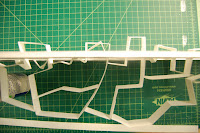For the next part of our project, we are continuing development by investigating different ways of representation. This is done by "drawing without paper," taking the parameters of our two dimensional drawing that we have already created of our projects and represent them as three dimensional objects.
We have to create 2 drawings, one dealing with tectonic and one with stereotomic.
At the first attempt of the tectonic drawing, I choose a section drawing to represent, using wire to produce the forms as well as part of the edge of the paper.




For my second attempt, I represented a axon drawing. With reference to Gego, I tried to use more solid wire to represent the ground line.

After these two attempts, I realized I needed to improve my wire bending skills to create more pristine bends as well as create more depth within my drawing. In a third attempt, incorporating elements from the two previous try's, a third was produce. Attempting to have it still read as a two dimensional image but as you move around the drawing the depth of the drawing is apparent.









 final tectonic drawing
final tectonic drawing final stereotomic drawing
final stereotomic drawing























